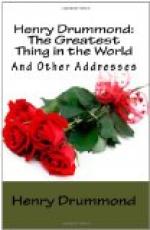I need not recall the whole illustration. It is the parable of the Vine. Did you ever think why Christ spoke that parable? He did not merely throw it into space as a fine illustration of general truths. It was not simply a statement of the mystical union, and the doctrine of an indwelling Christ. It was that; but it was more. After He had said it, He did what was not an unusual thing when He was teaching His greatest lessons—He turned to the disciples and said He would tell them why He had spoken it. It was to tell them
HOW TO GET JOY.
“These things have I spoken unto you,” He said, “that My Joy might remain in you, and that your Joy might be full.” It was a purposed and deliberate communication of His
SECRET OF HAPPINESS.
Go back over these verses, then, and you will find the Causes of this Effect, the spring, and the only spring, out of which true Happiness comes. I am not going to analyze them in detail. I ask you to enter into the words for yourselves.
Remember, in the first place, that the Vine was the Eastern symbol of Joy. It was its fruit that made glad the heart of man. Yet, however innocent that gladness—for the expressed juice of the grape was the common drink at every peasant’s board—the gladness was only a gross and passing thing. This was not true happiness, and the vine of the Palestine vineyards was not the true vine. “Christ was the true Vine.” Here, then, is the ultimate source of Joy. Through whatever media it reaches us, all true Joy and Gladness find their source in Christ.
By this, of course, is not meant that the actual Joy experienced is transferred from Christ’s nature, or is something passed on from Him to us. What is passed on is His method of getting it. There is, indeed, a sense in which we can share another’s joy or another’s sorrow. But that is another matter. Christ is the source of Joy to men in the sense in which He is the source of Rest. His people share His life, and therefore share its consequences, and one of these is Joy. His method of living is one that in the nature of things produces Joy. When He spoke of His Joy remaining with us He meant in part that the causes which produced it should continue to act. His followers, (that is to say), by repeating His life would experience its accompaniments. His Joy, His kind of Joy, would remain with them.
The medium through which this Joy comes is next explained: “He that abideth in Me, the same bringeth forth much fruit.” Fruit first, Joy next; the one the cause or medium of the other. Fruit-bearing is the necessary antecedent; Joy both the necessary consequent and the necessary accompaniment. It lay partly in the bearing fruit, partly in the fellowship which made that possible. Partly, that is to say, Joy lay in mere constant living in Christ’s presence, with all that that implied of peace, of shelter, and of love; partly in the influence of that Life upon mind and character and will; and partly in the inspiration to live and work for others, with all that that brought of self-riddance and joy in others’ gain. All these, in different ways and at different times, are




